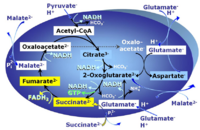PGMS-pathway control state: Difference between revisions
From Bioblast
m (moved PGMS to PGMS pathway control state) |
No edit summary |
||
| Line 3: | Line 3: | ||
|description=[[File:PGMS.png|left|200px|PGMS]] '''PGMS''': [[Pyruvate]] & [[Glutamate]] & [[Malate]] & [[Succinate]]. | |description=[[File:PGMS.png|left|200px|PGMS]] '''PGMS''': [[Pyruvate]] & [[Glutamate]] & [[Malate]] & [[Succinate]]. | ||
'''MitoPathway control:''' | '''MitoPathway control state:''' NS | ||
2-oxoglutarate is produced through the citric acid cycle from citrate by isocitrate dehydrogenase, from oxaloacetate and glutamate by the transaminase, and from glutamate by the glutamate dehydrogenase. If the 2-oxoglutarate carrier does not outcompete these sources of 2-oxoglutarate, then the TCA cycle operates in full circle with external pyruvate&malate&glutamate&succinate | 2-oxoglutarate is produced through the citric acid cycle from citrate by isocitrate dehydrogenase, from oxaloacetate and glutamate by the transaminase, and from glutamate by the glutamate dehydrogenase. If the 2-oxoglutarate carrier does not outcompete these sources of 2-oxoglutarate, then the TCA cycle operates in full circle with external pyruvate&malate&glutamate&succinate | ||
| Line 12: | Line 11: | ||
|mitopedia concept=Respiratory state, SUIT state | |mitopedia concept=Respiratory state, SUIT state | ||
}} | }} | ||
== PGMS(L) == | == PGMS(L) == | ||
| Line 25: | Line 21: | ||
== Discussion == | == Discussion == | ||
Recent studies showed that | :::: Recent studies showed that S- and NS-linked OXPHOS capacity is inhibited by 2 mM malate concentrations as applied in many SUIT protocols. This inhibition is less pronounced at higher succinate concentrations (10 mM up to 50 mM S). | ||
Revision as of 10:33, 8 November 2016
Description
PGMS: Pyruvate & Glutamate & Malate & Succinate.
MitoPathway control state: NS
2-oxoglutarate is produced through the citric acid cycle from citrate by isocitrate dehydrogenase, from oxaloacetate and glutamate by the transaminase, and from glutamate by the glutamate dehydrogenase. If the 2-oxoglutarate carrier does not outcompete these sources of 2-oxoglutarate, then the TCA cycle operates in full circle with external pyruvate&malate&glutamate&succinate
Abbreviation: PGMS
Reference: Gnaiger 2014 MitoPathways - Chapter 5.6
MitoPedia concepts:
Respiratory state,
SUIT state
PGMS(L)
PGMS(P)
PGMS(E)
Discussion
- Recent studies showed that S- and NS-linked OXPHOS capacity is inhibited by 2 mM malate concentrations as applied in many SUIT protocols. This inhibition is less pronounced at higher succinate concentrations (10 mM up to 50 mM S).

